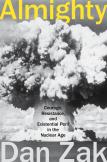America's love-hate relationship with the nuclear bomb
It has been four years since three activists entered a nuclear weapons plant in Oak Ridge, Tenn. Under the cover of early morning darkness, an octogenarian Catholic nun, along with a house painter and a Vietnam veteran, crested a low pine ridge and walked onto the Y-12 National Security Complex, supposedly one of the most secure sites in the world. Using bolt cutters purchased at Target for $25, they snipped through three fences, hung peace banners and spray-painted the walls of the Highly Enriched Uranium Material Facility, a massive, castle-like structure that housed enough uranium to power thousands of nuclear bombs. Architects had designed its walls to withstand a crashing jet but probably never considered an assault of biblical graffiti.
“Woe to an empire of blood,” wrote one activist.
“The fruit of justice is peace,” wrote another.
The three then prayed and waited to be arrested.
Upon learning the news, Dan Zak, a journalist at The Washington Post, paid close attention as U.S. lawmakers railed, first reporting on the breach at Oak Ridge in a beautifully crafted piece for the newspaper’s style magazine. That article evolved into Almighty, one of the most captivating and penetrating books about the United States’ love-hate relationship with the bomb I have ever read.
Zak is a terrific writer. His chronicle of our nuclear complex—from the bomb’s creation to the present-day modernization of our nuclear arsenal—unfurls like a film, with drama, suspense and an eye for horrifying absurdities. Describing the nuclear bombing of Hiroshima, he notes the Japanese city “was erased by an amount of uranium that weighed no more than a human fetus at 28 weeks.”
Mary Shelley’s Frankenstein comes to mind. Except here, the monster is not craving connection. It does not get killed. It shapeshifts, appearing as the preserver of global security when its function is planetary annihilation.
Zak tells this history of apocalyptic possibilities through the lens of personal stories. His central characters are four ordinary Americans: the three activists Sister Megan Rice, Michael Walli and Greg Boertje-Obed, and the Y-12 security guard, Kirk Garland, who first discovered the peace protestors outside the Oak Ridge nuclear facility and was later fired for treating them humanely instead of drawing his gun. Among the supporting cast are scientists who conceive the bomb, presidents publicly urging nuclear disarmament, yet sanctioning the expansion of our arsenals, bomb-makers, true believers, dissenters and victims.
Dear God, the victims! Many of us know about the Japanese vaporized at Hiroshima and Nagasaki and the cancerous fate of the cities’ survivors. But what of the hundreds of thousands of U.S. atomic veterans—pilots flying unaware through mushroom clouds, ground soldiers standing in the radiated glow of desert tests?
“They lost hair and teeth in the short run,” Zak writes. “In the long run: thyroid problems, multiple myeloma, slow and agonizing deaths in their 50’s and 60’s.” High suicide rates plagued Oak Ridge and the Marshall Islands, where the United States conducted 66 nuclear tests. Cancer invaded the bodies of Americans who lived downwind from nuclear weapons plants. Brain damage and premature death felled their workers.
Catholics on both sides of the nuclear divide are featured prominently here. Richard McSorley, S.J., a pacifist of vigorous intellect, declares nuclear weapons to be “the taproot of all violence.” Leroy Matthiesen, a pastoral Catholic bishop in Texas, urges his parishioners working at the Pantex nuclear weapons plant to quit their jobs. No such sermons are heard at St. Mary’s Catholic Church in Oak Ridge, where the faithful receive holy Communion on Sunday and make weapons on Monday.
This is not a history we Americans like to ponder. To do so requires reckoning with the devil among us. As Zak so clearly reveals, the bomb we believe saved our boys and ended a world war also brought dark regret and ominous faith.
“It is an awful responsibility which has come to us,” President Harry Truman said after the nuclear leveling of Nagasaki. “We thank God that it has come to us instead of our enemies, and we pray that He may guide us to use it in His ways and for His purposes.”
Over the decades, that faith spawned a vast nuclear network “insulated from logic and reason,” Zak notes, and the United States became entrenched in a deadly paradox: We would keep the peace by threatening global destruction.
This book is essential reading for any American. The U.S. budget for nuclear weapons is now higher than at any point in history, despite a shrunken arsenal. Yet who is asking us to consider the consequences of this investment? Zak is, and he does so in a way that cuts through the psychic numbing and gives hope.
Almighty reminds us the United States, birthplace of the bomb, is also a land of prophets and visionaries, a country of unexpected converts (Henry Kissinger is now anti-nuke!), and committed believers in the value of life. In emphasizing the human dimension of our nuclear complex, the book reiterates what the peace protesters symbolically suggested when they penetrated the inner sanctum of Oak Ridge with their household tools and abundant conviction.
The devil among us is not the weapons but our faith in them. Having made them, we can unmake them, if we but, to quote Sister Megan, “change the mission.”
This article also appeared in print, under the headline “Our Nuclear Complex,” in the December 19-26, 2016, issue.








